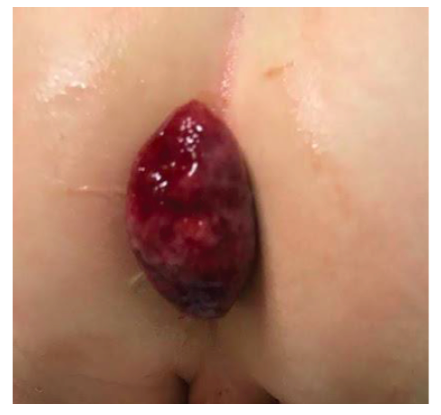Imaging cases
Gastroenterological clinical case
Caso clínico de Gastrenterologia
Mariana Portela1
Catarina Barroso2
José Luís Carvalho2
Maria Miguel Gomes1
3
1. Department of Pediatrics, Hospital de Braga. 4710-243 Braga, Portugal, mariana.fpo@homail.com; mariamiguelsagomes@gmail.com
2. Department of Pediatric Surgery, Hospital de Braga. 4710-243 Braga, Portugal, catabarroso@gmail.com; jlafcarvalho@gmail.com
3. School of Medicine, Universidade do Minho. 4710-057 Braga, Portugal, mariamiguelsagomes@gmail.com
Abstract
Gastrointestinal polyps are frequent in children and represent the most common cause of colorectal bleeding in this age group. Among those, juvenile polyps are the most frequently found. Intermittent mild hematochezia is the main symptom of colon polyps. Most polyps are pedunculated and, when located in the rectum, may prolapse. In most cases, juvenile polyps are solitary and located in rectosigmoid. Although malignancy risk of a solitary juvenile polyp is very small, excision is recommended to confirm benign nature. Total colonoscopy should be considered to exclude multiple or proximal polyps.
Keywords: children; hematochezia; juvenile polyp
Resumo
Os pólipos gastrointestinais são frequentes em idade pediátrica e são a causa mais comum de hemorragia colorretal nesta faixa etária. Destes, os pólipos juvenis são os mais comuns. A hematoquézia intermitente é o principal sintoma de pólipos localizados no cólon. A maioria dos pólipos é pedunculada e, quando localizados no reto, podem prolapsar. Na maior parte dos casos, os pólipos juvenis são solitários e localizam-se no retossigmóide. Embora o risco de malignidade de um pólipo juvenil solitário seja muito baixo, é recomendada excisão para confirmar a sua benignidade. A colonoscopia total deve ser considerada para excluir pólipos múltiplos ou proximais.
Palavras-chave: crianças; hematoquézia; pólipo juvenil
A two-year-old boy presented with a six-month history of painless hematochezia, described as a small amount of bright red blood dripping and sometimes bright red blood mixed with normal stool. He was previously healthy and with no family history of gastrointestinal diseases. The boy presented to the Emergency Department due to exteriorization of a mass after defecation (Figure 1). No history of fever, abdominal pain, vomiting, diarrhea, additional blood losses, or other symptoms was identified and he was hemodynamically stable. On examination, the patient had a rounded and mobile mass with nearly 3cm of diameter protruding in the anus. The remaining examination was unremarkable.
What is your diagnosis?
Diagnosis
Gastrointestinal Polyp - Juvenile Polyp
Discussion
Juvenile polyps resulting in lower gastrointestinal bleeding or prolapse require polypectomy. In this case, surgery consisted in pedicle cerclage and mass excision. The procedure was uneventful and the child was successfully discharged after eight hours of surveillance. Histologic examination confirmed the diagnosis of a 2.9-cm juvenile polyp (hamartoma). Total colonoscopy was planned to exclude multiple or proximal polyps, documented to occur in 24% and 15% of cases, respectively.1
Gastrointestinal polyps are common in children and usually benign.1-4 The diagnosis is most often established during the first decade of life, with a peak incidence between the ages of two and six years.2-3 The condition is predominant in the male gender.1 Gastrointestinal polyps may occur anywhere in the alimentary tract.1-4 In preschool children and adolescents, 85% of polyps are juvenile, 10% are adenomas, and 3% are hyperplasic.2 Most juvenile polyps are unique and located in the rectum and sigmoid and sometimes can be accessible by rectal touch.1-3 The most common symptom of juvenile polyps is intermittent mild hematochezia.1,2 Rarely, they may be accompanied by hemodynamic or hematologic alterations, as stool passing through the polyp may cause bleeding.2,3 Most polyps are pedunculated and can prolapse when located in rectum, as in the present case.2 Usually no pain is described, but polyp traction can cause discomfort. Although the risk of malignancy associated with a solitary juvenile polyp is very small, excision is recommended to confirm benignity. The recurrence rate was considered rare in older series, but more recent studies report recurrence in 17% of patients with single juvenile polyps.1,2 Patient surveillance depends of the number of identified polyps and family history.2
References
1. Lee BG, Shin SH, Lee YA, Wi JH, Lee YJ, Park JH. Juvenile Polyp and Colonoscopic Polypectomy in Childhood. Pediatr Gastroenterol Hepatol Nutr. 2012; 15:250-255. https://doi.org/10.5223/pghn.2012.15.4.2502.
[ Links ]
2. Patel N, K Marsha , Stephen J Teach, Heyman MB, Hoppin AG. Lower gastrointestinal bleeding in children: causes and diagnostic approach. Uptodate. Accessed in april 2019. Available from: https://www.uptodate.com/contents/lower-gastrointestinal-bleeding-inchildren-causes-and-diagnosticapproach?search=juvenile%20polyposis&source=search_result&selectedTitle=4~19&usage_type=default&display_ran k=4.
[ Links ]
3. Pereira F. Gastrenterologia Pediátrica: aspetos práticos. Sociedade Portuguesa de Endoscopia Digestiva. 2010. Available from: http://www.sped.pt/index.php/publicacoes/publicacoes-sped/664-gastrenterologia-pediatrica-aspectos-praticos.
[ Links ]
4. Wang LC, Lee HC, Yeung CY, Chan WT, Jiang CB. Gastrointestinal polyps in children. Pediatr Neonatol. 2009; 50:196-201
[ Links ]















